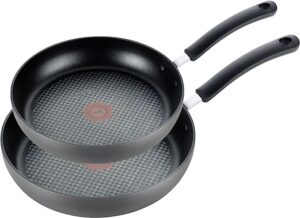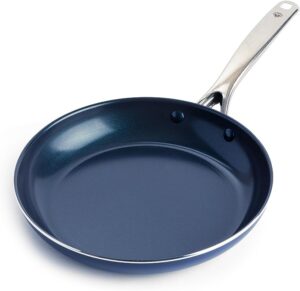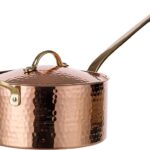How to Care for Nonstick Pans?

In every kitchen, nonstick pans have become a cherished companion for effortless cooking. Their slick surfaces are a blessing when you want to flip pancakes with finesse or slide omelets onto plates with ease. However, these kitchen workhorses need more than a quick rinse to maintain their charm. Proper care for nonstick pans is not only about preserving their gleaming appearance but also about extending their functionality and lifespan.
Without the right treatment, the nonstick coating can lose its magic, making your kitchen adventures a tad less enjoyable. In this comprehensive guide, we’ll explore the art of caring for nonstick pans, from basic cleaning tips to advanced maintenance techniques, ensuring that your trusty kitchen allies remain in their prime. So, let’s dive into the world of care for nonstick pans and unveil the secrets to keeping them at their best.
Five Of The Best 6 Inch Nonstick Frying Pans in 2023
Why Should We Care For Nonstick Pans?
Nonstick pans, while exceptional in their performance, can be delicate souls that require specialized care. To understand why, it’s essential to recognize the factors that make nonstick pans susceptible to wear and tear.
The primary vulnerability lies in the nonstick coating itself, which is designed to release food effortlessly. This coating, a thin layer applied to the pan’s surface, is prone to damage from high heat, abrasive materials, and sharp-edged utensils. Excessive heat can cause the coating to break down, resulting in food sticking to the pan, defeating the primary purpose of nonstick cookware.
Furthermore, common practices like using metal utensils or stacking pans without protection can lead to scratches and premature wear of the coating. In this guide on care for nonstick pans, we’ll delve into the dos and don’ts to help you preserve your pans and maintain their exceptional nonstick performance.
Basic Cleaning and Maintenance for Nonstick Pans:
To care for nonstick pans can be straightforward, provided you adhere to a few fundamental guidelines in your daily routine to properly care for nonstick pans.
- When cleaning nonstick pans, your choice of utensils plays a pivotal role. Opt for utensils made from materials that won’t scratch the nonstick coating, such as silicone, wood, or plastic. Using metal utensils can quickly erode the nonstick surface, making it less effective over time. After cooking, allow the pan to cool slightly before cleaning. Hot pans are more susceptible to damage, so this brief cooling period can help preserve the nonstick coating.
- When it comes to cleaning, avoid harsh scouring pads or abrasive detergents. Instead, use a gentle, non-abrasive sponge or cloth. If you encounter stubborn residues, soak the pan in warm, soapy water for a brief period before cleaning. Hand washing is typically the best practice, as dishwashers can subject your nonstick pans to harsh detergents and high water temperatures that may lead to faster wear and tear.
- The next crucial step in caring for nonstick pans is proper drying. After washing, thoroughly dry the pan with a soft, dry cloth or towel. Storing a damp or wet pan can foster corrosion, which is detrimental to the pan’s surface.
- When it comes to storing your nonstick pans, take measures to protect the nonstick coating from scratches and peeling. Placing a soft, cloth or paper towel between pans when stacking them can prevent abrasive contact. Additionally, consider investing in pan protectors or storing your pans individually, which is a surefire way to preserve the nonstick surface.
Safe Cooking Practices for Nonstick Pans:
In addition to proper cleaning and maintenance, adopting safe cooking practices is essential to preserving the nonstick coating.
- When using nonstick pans, it’s advisable to cook with low to medium heat. Excessive heat can be detrimental to the nonstick surface, leading to quicker degradation. This simple adjustment is not only a good way to care for nonstick pans but also contributes to healthier cooking as it minimizes the risk of harmful fumes that can be released at high temperatures.
- While nonstick pans are designed to reduce the need for cooking oils, using them sparingly can be beneficial. A small amount of oil or butter can enhance the cooking process, but excessive use can cause a buildup that’s challenging to remove, potentially leading to a decline in the pan’s nonstick properties.
- To care for nonstick pans, It’s also crucial to avoid cooking sprays. Many cooking sprays contain propellants that can leave a residue on the nonstick surface, creating a stubborn, gummy layer that can be challenging to clean.
When to Replace Your Nonstick Pan:
Apart from knowing how to care for nonstick pans, knowing when it’s time to bid farewell to your nonstick pan is crucial for both safety and cooking performance. Watch for the following signs of nonstick coating deterioration:
- Surface Scratches: Minor surface scratches are normal with use and usually don’t affect cooking. However, if you notice deep scratches or the nonstick coating begins to flake or peel, it’s a strong indication that the pan has reached the end of its lifespan.
- Food Sticking: If food starts sticking to the pan even when you’re using the appropriate cooking techniques, it may be time for a replacement. This sticking occurs because the nonstick coating has worn off in spots.
- Uneven Heating: When your nonstick pan no longer heats evenly, it can lead to unevenly cooked food. Hot spots and cold spots are often the result of a damaged or worn-out nonstick surface.
- Warped or Bent Pan: A warped or bent pan won’t make proper contact with your stovetop. This can lead to heat distribution issues and make it challenging to cook food evenly.
- Safety Concerns: If the nonstick coating is severely damaged or peeling, it poses safety risks. Inhaling fumes from overheated nonstick coating can cause flu-like symptoms known as “polymer fume fever.” For safety reasons, it’s best to replace the pan when you notice extensive damage.
In conclusion, caring for nonstick pans is an essential practice for every home chef. Proper care for nonstick pans not only prolongs their lifespan but also maintains the delightful experience of cooking without stubborn food residues sticking to the surface. By following our guide on how to care for nonstick pans, you can ensure that your cookware remains in excellent condition for years to come. With the right techniques, you’ll enjoy safe, efficient, and reliable cooking, making “care for nonstick pans” an indispensable kitchen ritual. So remember, embrace these best practices to safeguard your investment and savor the convenience of nonstick cookware.







